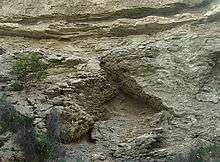Messinian
| System/ Period |
Series/ Epoch |
Stage/ Age |
Age (Ma) | |
|---|---|---|---|---|
| Quaternary | Pleistocene | Gelasian | younger | |
| Neogene | Pliocene | Piacenzian | 3.600–2.58 | |
| Zanclean | 5.333–3.600 | |||
| Miocene | Messinian | 7.246–5.333 | ||
| Tortonian | 11.62–7.246 | |||
| Serravallian | 13.82–11.62 | |||
| Langhian | 15.97–13.82 | |||
| Burdigalian | 20.44–15.97 | |||
| Aquitanian | 23.03–20.44 | |||
| Paleogene | Oligocene | Chattian | older | |
| Subdivision of the Neogene Period according to the IUGS, [v2014/02]. | ||||
The Messinian is in the geologic timescale the last age or uppermost stage of the Miocene. It spans the time between 7.246 ± 0.005 Ma and 5.332 ± 0.005 Ma (million years ago). It follows the Tortonian and is followed by the Zanclean, the first age of the Pliocene.
The Messinian overlaps the Turolian European Land Mammal Mega Zone (more precise MN 12 and 13) and the Pontian Central European Paratethys stage. It also overlaps the late Huayquerian and early Montehermosan South American Land Mammal Ages, and falls inside the more extensive Hemphillian North American Land Mammal Age.
During the Messinian, around 6 million years ago, the Messinian salinity crisis took place, which brought about repeated desiccations of the Mediterranean Sea.
Definition

The Messinian was introduced by Swiss stratigrapher Karl Mayer-Eymar in 1867.[1] Its name comes from the Italian city of Messina on Sicily, where the Messinian evaporite deposit is of the same age.
The base of the Messinian is at the first appearance of the planktonic foram species Globorotalia conomiozea and is stratigraphically in the middle of magnetic chronozone C3Br.1r. The Global Boundary Stratotype Section and Point for the Messinian is located in a section at Oued Akrech, near the Moroccan capital Rabat.[2]
The top of the Messinian (the base of the Zanclean stage and Pliocene series) lies with the top of magnetic chronozone Cr3 (about 100,000 years before the Thvera normal subchronozone C3n.4n). The top is also close to the extinction level of the calcareous nanoplankton species Triquetrorhabdulus rugosus (the base of biozone CN10b) and the first appearance of nanoplankton Ceratolithus acutus.
References
Notes
- ↑ Mayer-Eymar, Karl (1867) Catalogue systématique et descriptif des fossiles des terrains tertiaires qui se trouvent du Musée fédéral de Zürich (Zürich, Switzerland: Librairie Schabelitz, 1867), page 13. From page 13: "Dans ces circonstances, je crois qu'il m'est permis comme créateur d'une classification conséquente et logique de proposer pour l'étage en question un nom qui lui convient en tous points. Ce nom est celui d'Etage messinien." (In these circumstances, I think that I am permitted as the creator of a consistent and logical classification to propose for the stage in question a name that suits it in every way. That name is that of the Messinian stage.)
- ↑ This GSSP was established by Hilgen et al. (2000)
Sources
- Gradstein, F.M.; J.G. Ogg; A.G. Smith (2004). A Geologic Time Scale 2004. Cambridge University Press.
- Hilgen, F.J.; S. Iaccarino; W. Krijgsman; G. Villa; C.G. Langereis; W.J. Zachariasse (2000). The Global Boundary Stratotype Section and Point (GSSP) of the Messinian Stage (uppermost Miocene). pp. 172–178.
- Hsü, K.J. (1983). The Mediterranean Was a Desert. Princeton: Princeton University Press.
- Mayer-Eymar, Karl (1867). Catalogue systématique et descriptif des fossiles des terrains tertiaires qui se trouvent du Musée fédéral de Zürich (in French). Zürich.
External links
| Wikimedia Commons has media related to Messinian. |
| Wikisource has original works on the topic: Cenozoic#Neogene |
- GeoWhen Database - Messinian
- Messinian online - living in an evaporitic world - Mediterranean area
- Neogene timescale, at the website of the subcommission for stratigraphic information of the ICS
- Neogene timescale at the website of the Norwegian network of offshore records of geology and stratigraphy
| Neogene Period | |||
|---|---|---|---|
| Miocene | Pliocene | ||
| Aquitanian | Burdigalian Langhian | Serravallian Tortonian | Messinian |
Zanclean | Piacenzian | ||
Coordinates: 33°56′13″N 6°48′45″W / 33.9369°N 6.8125°W